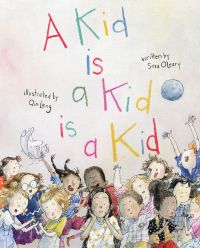A Kid Is a Kid Is a Kid
Éditeur : Groundwood Books Ltd
ISBN numérique ePub: 9781773062518
Parution : 2021
Catégorisation :
Livres numériques /
Autre /
Autre /
Autre.
Formats disponibles
| Format | Qté. disp. | Prix* | Commander |
|---|---|---|---|
| Numérique ePub Protection filigrane*** |
Illimité | Prix : 6,99 $ |
*Les prix sont en dollars canadien. Taxes et frais de livraison en sus.
***Ce produit est protégé en vertu des droits d'auteurs.
Description
In this companion to the enormously popular A Family Is a Family Is a Family, a group of kids share the silly questions they always hear, as well as the questions they would rather be asked about themselves.
Being the new kid is hard, a child in the school playground tells us. I can think of better things to ask than if I’m a boy or a girl. Another child comes along and says she gets asked why she always has her nose in a book. Someone else gets asked where they come from.
One after another, children share the questions they’re tired of being asked again and again — as opposed to what they believe are the most important or interesting things about themselves. As they move around the playground, picking up new friends along the way, there is a feeling of understanding and acceptance among them. And in the end, the new kid comes up with the question they would definitely all like to hear: “Hey kid, want to play???
Sara O’Leary’s thoughtful text and Qin Leng’s expressive illustrations tell a story about children who are all different, all themselves, all just kids.
Key Text Features
dialogue
Correlates to the Common Core State Standards in English Language Arts:
CCSS.ELA-LITERACY.RL.1.6
Identify who is telling the story at various points in a text.
CCSS.ELA-LITERACY.RL.1.7
Use illustrations and details in a story to describe its characters, setting, or events.
CCSS.ELA-LITERACY.RL.2.1
Ask and answer such questions as who, what, where, when, why, and how to demonstrate understanding of key details in a text.
CCSS.ELA-LITERACY.RL.2.6
Acknowledge differences in the points of view of characters, including by speaking in a different voice for each character when reading dialogue aloud.
CCSS.ELA-LITERACY.RL.2.7
Use information gained from the illustrations and words in a print or digital text to demonstrate understanding of its characters, setting, or plot.
CCSS.ELA-LITERACY.RL.3.1
Ask and answer questions to demonstrate understanding of a text, referring explicitly to the text as the basis for the answers.
CCSS.ELA-LITERACY.RL.3.7
Explain how specific aspects of a text's illustrations contribute to what is conveyed by the words in a story (e.g., create mood, emphasize aspects of a character or setting)























